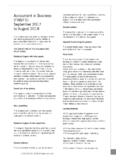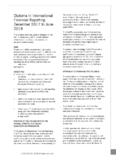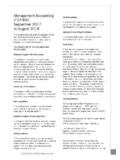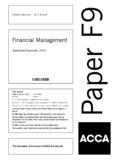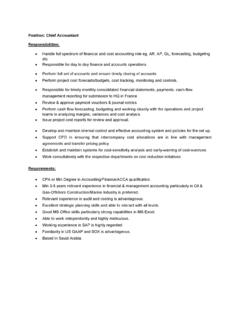Transcription of Performance Reporting - an eye on the facts - ACCA Global
1 An eye on the facts A KPMG and acca Thought Leadership ReportPerformance ReportingCONTENTSA bout the research 4 Introduction 6 Executive summary 7 Build the right data and governance foundation 8 Structure the delivery model for success 14 Empower Finance professionals to collaborate with the business effectively 20 About the authors 26123 2015 KPMG LLP, a UK limited liability partnership and a member firm of the KPMG network of independent member firms affiliated with KPMG International Cooperative ( KPMG International ), a Swiss entity. All rights EYE ON THE facts | 3 THIS REPORT REPRESENTS THE VIEW OF OVER 1,100 FINANCE PROFESSIONALS FROM MORE THAN 50 COUNTRIES* EPM consists of Planning, budgeting & forecasting , Performance Reporting and Dimensional Profitability (including costing)ABOUT THE RESEARCHThis Global report is the second of three pieces of research that have been jointly commissioned by acca and KPMG to evaluate how the Enterprise Performance Management (EPM)* capability within Finance functions is providing the Chief Financial Officer (CFO) with the appropriate people, processes and technology to deliver effective and efficient Performance Reporting .
2 The data used in the report is from a survey which was conducted between 11th September 2015 and 28th September 2015, and represents the views of over 1,100 Finance professionals from more than 50 countries. Whilst employees from organisations of all sizes participated in the survey, over 60 percent were from organisations with over 1,000 employees with annual turnover of at least $100m. In addition, 35 percent of the respondents identified themselves as a Senior Finance Manager/Manager, 20 percent as newly qualified/experienced Accountants, 11 percent as Financial Controllers, 7 percent as Directors/Partners, 6 percent as CFOs and the remaining 21 percent spread between a range of roles that included CEO, Internal Audit, Treasury Analysts and Consultants.| AN EYE ON THE facts 2015 KPMG LLP, a UK limited liability partnership and a member firm of the KPMG network of independent member firms affiliated with KPMG International Cooperative ( KPMG International ), a Swiss entity.
3 All rights reserved. 2015 KPMG LLP, a UK limited liability partnership and a member firm of the KPMG network of independent member firms affiliated with KPMG International Cooperative ( KPMG International ), a Swiss entity. All rights EYE ON THE facts | 45 EXECUTIVE SUMMARY Performance Reporting at its best should enable a business to link its operational activity and decision making with the attainment of its strategy. It gives organisations the essential information to make more confident and effective decisions, focuses the attention of management on activities that truly matter, and provides a consistent view of actual Performance across the business. Yet, despite the opportunity that exists in the face of ever-increasing volumes of data and disruptive technologies, this study suggests current Performance Reporting processes are flawed, and many enterprises continue to proceed with information that is ineffective in the support of rapid and informed decision making.
4 The result is missed value delivery opportunities and slow responses to emerging study suggests there are three critical areas to focus on to improve current Performance Reporting capability and provide the business with information which can drive Our view is that Performance Reporting should be developed within a Performance management framework consisting of three core components (the other two being Planning, budgeting & forecasting and Profitability/Costing analytics) which collectively organisations can use to convert data into insightful, relevant and timely management information that is at the kernel of supporting fact based decision offers a competitive advantage to an organisation that undertakes such an investment in their Performance Reporting capability. With the volume of both internal and external data increasing exponentially, coupled with the unrelenting demand for more information from the business, organisations need to take the time to truly consider what information they really need to achieve their strategic objectives and hence drive value and how to deliver it in an efficient and effective manner.
5 Achieving a balance between this supply and demand is key to achieving success in Performance leading the way are building a framework that provides a seamless link between the organisation s strategic objectives, measurement of Performance against such objectives and operational decision making. This ensures that organisations are able to see through the current haze of available data and produce information which in turn informs better , too many organisations are weighed down by a mass of Performance reports. These often contain far too many metrics (which are frequently in conflict with one another) and far too little insight, and thus these organisations are unable to clearly analyse past and anticipated Performance in order to make better a result, Finance are often left working round-the-clock to produce reports that neither meets the demands of stakeholders nor offers the business an informed, value-adding view of its FINANCE PROFESSIONALS TO COLLABORATE WITH THE BUSINESS EFFECTIVELYSTRUCTURE THE DELIVERY MODEL FOR SUCCESSSUPPLYDEMANDn There must be a focus on collecting the data that really matters to the organisation what is the right data to support an integrated set of defined key Performance In addition, data quality is imperative, and is the bedrock upon which a Performance Reporting capability should be built, ensuring that there is absolute trust in the data provided to the business.
6 N It is also essential that this data is supported by a robust governance structure to ensure integrity in the data is maintained on a sustainable basis. n The management team needs Performance information which is consistent, controlled, timely, relevant, complete and delivered in a cost-efficient How the Finance function is structured, and how efficiently and effectively it delivers its Performance Reporting capability, will determine The ultimate goal of Performance Reporting is increased speed and quality of decision making in the business to deliver a sustainable competitive advantagen The skills and behaviours that Finance professionals bring, and the provision of appropriate technologies to support them, form the essential groundwork to achieving this step change in THE RIGHT DATA AND GOVERNANCE FOUNDATIONDataProcessPeopleInvestorsExec FunctionsBUsBUsBUsBUs DELIVERY 2015 KPMG LLP.
7 A UK limited liability partnership and a member firm of the KPMG network of independent member firms affiliated with KPMG International Cooperative ( KPMG International ), a Swiss entity. All rights reserved. 2015 KPMG LLP, a UK limited liability partnership and a member firm of the KPMG network of independent member firms affiliated with KPMG International Cooperative ( KPMG International ), a Swiss entity. All rights EYE ON THE facts | 76| AN EYE ON THE FACTSBUILD THE RIGHT DATA AND GOVERNANCE FOUNDATION1In the knowledge economy, optimised and appropriate use of data is central to helping organisations make better decisions, create competitive advantage and successfully deliver its strategy. For Performance Reporting to be truly effective, a common data hierarchy needs to be successfully deployed across the enterprise around the right key Performance indicators (KPIs) of the organisation.
8 This in practice is underpinned by data which supports the representation of a single version of the truth. The good news is that this study suggests progress has been made in ensuring common KPIs are used consistently across the business. This is a great step towards being able to compare and understand Performance across the organisation consistently. Transparent metrics provide management with a clear line of sight on how the overall strategy across the organisation is being impacted by operational activity. However, there are three questions which must be addressed; 1. Are the Performance indicators used aligned to the strategy of the organisation?2. Is the data underpinning these Performance indicators consistent?3. Is the organisation managing data sustainably?Organisations may have consistent KPIs, but there is a danger that they could paint a misleading picture of Performance if they aren t focused using measures that are too inwardly focused or lagging in their nature risk losing sight of competitors.
9 Those with too outward a focus risk losing relevance and alignment against corporate strategy. KPIs, regardless of their focus, are only as consistent as the underlying data. Poor data input will create inconsistent measures, even if they are badged as the same KPI. This is why getting the basic data structures and data feeds right is so vital in providing decision support that can be THE SNAKES AND LADDERS OF Performance Reporting Nick Whitfeld | Director, KPMG Business IntelligenceEven the most successful companies are struggling to get basic information for decision making purposes. Companies face change from a host of sources, such as acquisitions, reorganisations, stiffening regulatory environments and changing IT systems. As an organisation s strategic priorities change, so do its information needs, and the constantly changing landscape makes it hard to keep disparate Reporting across an organisation aligned and consistent.
10 At times it can feel like a game of snakes and ladders two steps forward, then a change, and with it two steps back. But how big a problem is the issue of inconsistent information in reality? According to this survey, most believe their organisations are good at Reporting Performance across the business against a common set of Performance , this doesn t entirely gel with what I see on a daily basis. Even some of the UK s most highly regarded companies, and those who have heavily invested in their Finance teams and technology, cannot provide accurate sales or stock reports. They don t have common definitions for fundamental aspects of their business such as margin or spend .And it is this the enforcement of consistent information standards (which includes agreed definitions for common business terms) across the organisation that lies at the heart of organisations that successfully deliver trusted and useful information in a constantly changing course there is more to it.
